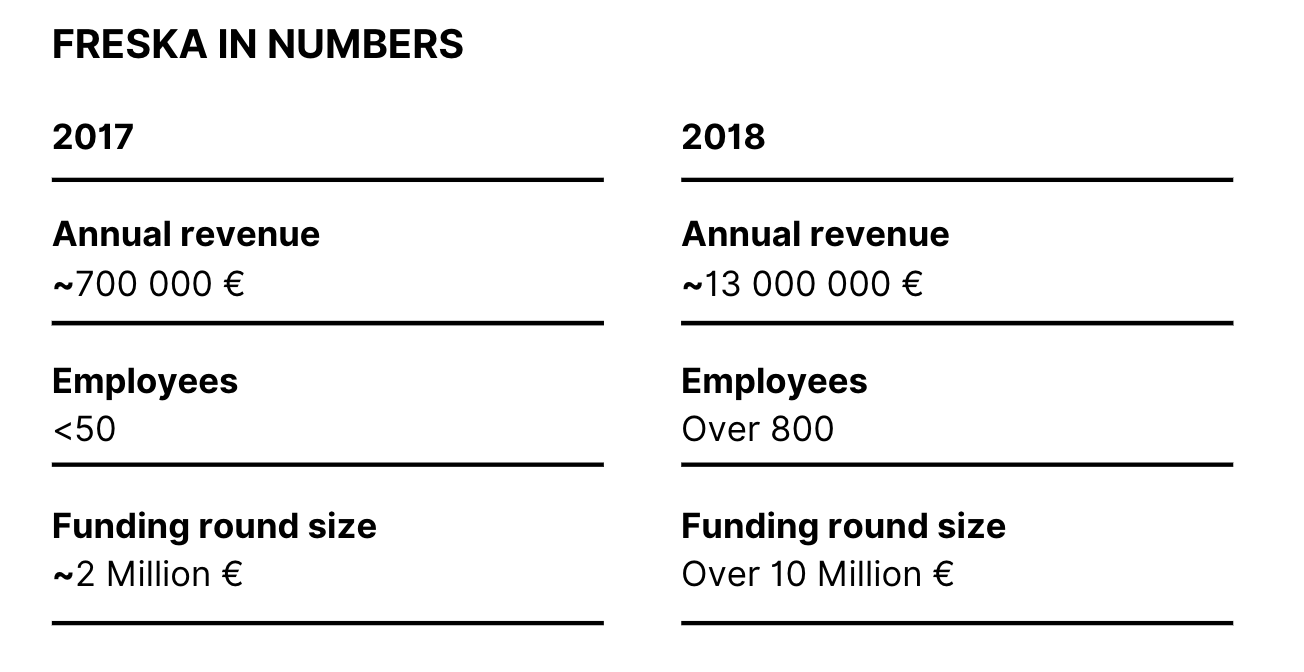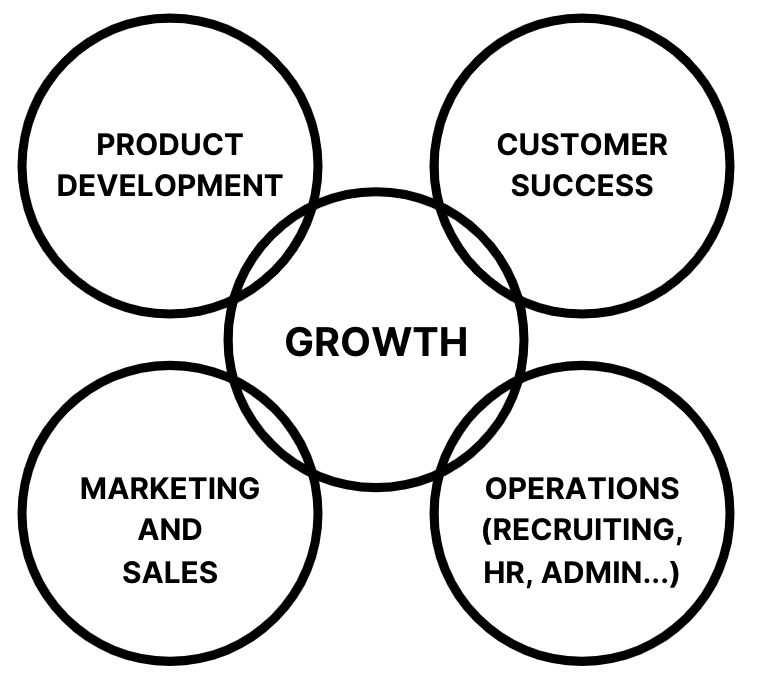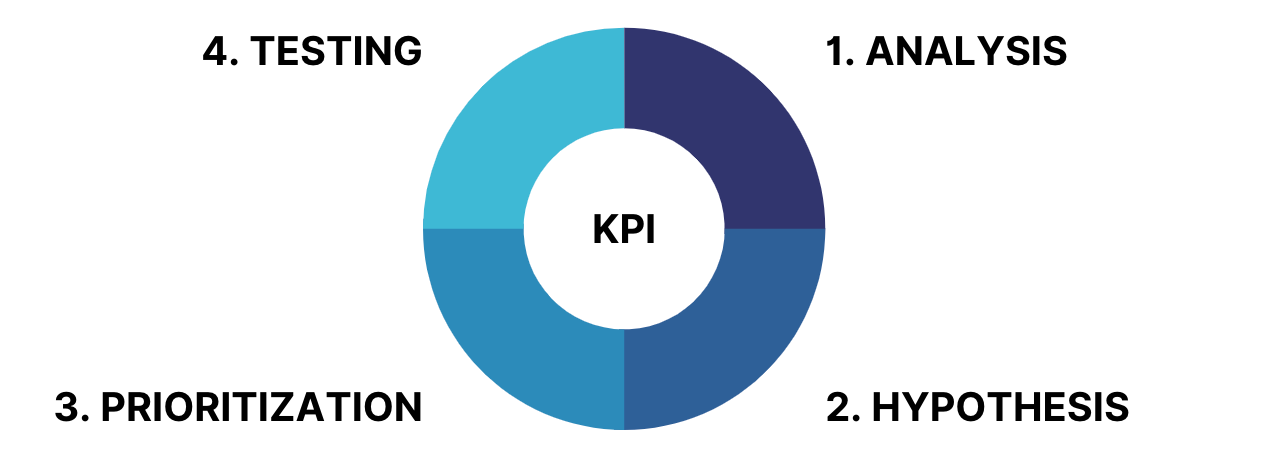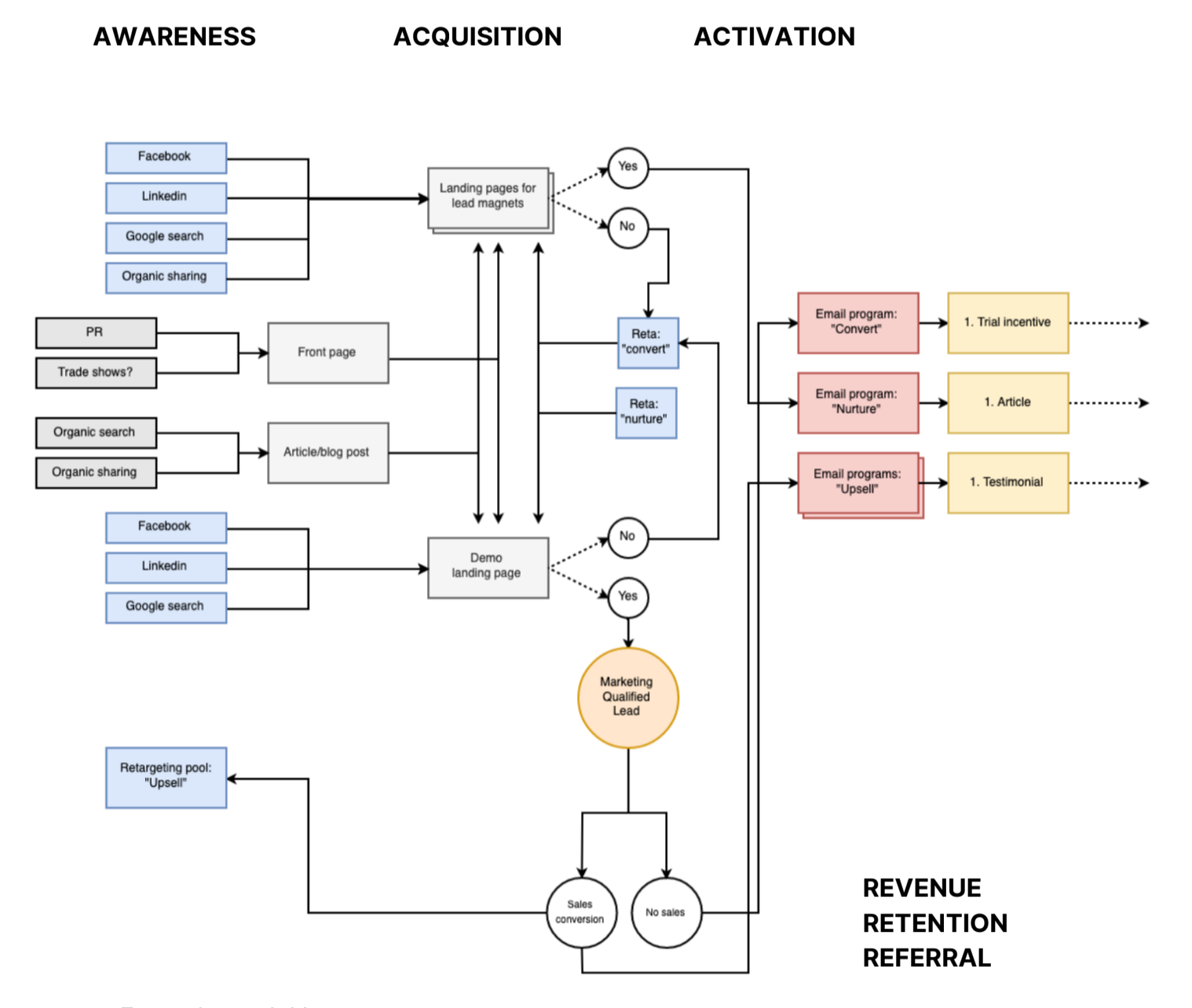Strategic Growth Hacking Operating System
Get started with cross-functional growth hacking used in hundreds of startups in Nordics and Baltics.

Growth hacking is a tool for systematic problem solving which can help you achieve your goals faster and more efficiently whether you’re an entrepreneur, CEO, or any other professional.
I've successfully used this unique combination of tactics that I developed at Freska (15% MoM Nordic home cleaning startup), Yousician (world's largest music education app), Paxful (world's largest P2P crypto market place), and hundreds of other startups in Finland, Sweden, and Estonia.
Currently I scale it by coaching early-stage startups at 140M€ VC-firm Icebreaker.vc, training growth hackers, and by my growth hacking as a service agency Truly.
A unique combination developed over extensive testing and iteration, you can start by following the four steps of the process and using the spreadsheets from the dashboard.
Tested and iterated over years in multiple companies and systems, this simple and efficient set of tools will accelerate your progress and make you more agile and productive.
Best,
Mari Luukkainen
Content
- Why growth hacking is important
- Goal of growth hacking
- Positioning growth hacking in your company
- Core process of growth hacking
- Aiming towards goals (OKR)
- Big picture, better focus (AAARRR)
- Testing
- Task management
- Communicating growth hacking in the company
- Pitfalls
Why growth hacking is important
Best practices of a cleaning company
Since the late 90s, I have been building affiliate websites and working with startups across sectors. I used to be amazed at the exponential growth of Silicon Valley companies that the Finnish companies couldn’t achieve due to a shortage of money, courage, determination, data-driven approach, speed, and skills.
My career took a new course when I was hired as Head of Growth in a home cleaning startup called Freska in 2017. During the two years I spent there, our business scaled rapidly. We expanded to Norway and Sweden. Global investors saw our potential and we raised an A round of over 10M€, which is significantly high for a cleaning company or even a Finnish startup.
Freska was one of the first Finnish companies to have a growth leader, and because of this, all of our operational parameters had improved systematically.
During my Freska years, I visited New York to meet Silicon Valley growth developers I had held in high esteem. These people had roles similar to mine in companies such as Airbnb, Uber, and Facebook.
In those conversations, I realized that they weren’t doing completely different things. They didn’t have any magic ingredients for their incredible growth. I understood that resources were important but they weren’t the key differentiator. What these high-growth companies did was rely on systematic and consistent growth development for decades.

Goal of growth hacking
Systematic problem solving
The goal of growth hacking is to use a systematic testing process to solve business problems and achieve objectives via continuous learning and iteration.
A systematic testing process focuses on bringing tests related to problem-solving or achieving goals from start to end in an agreed-upon cycle, and then analyzing them based on their learning experiences.
Here are the key components of the terminology for greater clarification:
- Systematic = Operations turned into repeatable routines.
- Testing = The focus is on testing, accepting that we do not know the end results when we start.
- Process = A routine that includes going through all the stages of a process.
- Problem-solving or achieving a goal = Testing with a focus on incremental steps toward a predetermined objective.
- Learning experience = Where test results are seen as valuable learning experiences.
Growth hacking is a tool independent of silos and can be used to increase efficiency in any function of a company, irrespective of its size or the lifecycle stage.
Positioning growth hacking in your company
Growth = Cooperation
Before applying growth hacking at a strategic level, the first concept to be understood is that growth is conditional upon and importantly, the most important offshoot of collaboration.
Many companies have their growth department stuck within the marketing department. However, business growth challenges cannot be solved by marketing alone. For growth hacking to be meaningful, all domains will have to actively participate in data collection and testing, centered around a team of specialists with growth hacking as their primary objective.
In other words, growth (hacking) needs its own department.
In the best-case scenario, you'll have the testing culture spread over the entire company. Self-guided units improving their operations based on data-led insights are an immensely valuable power source as the company grows.

Core process of growth hacking
A four-phase process
Strategic growth hacking is a four-phase process at its core. All growth hacking is tied to objectives and so, the first step is identifying your key performance indicator (KPI).
This might include revenue, website traffic, sales calls, or customer satisfaction. The important part about a KPI is that it will be periodically measurable. Once you choose our KPI, you can start the process of growth hacking using these four phases:
- Analysis: The first stage is where you analyze the existing situation or any learning experiences from the previous testing cycle.
- Hypothesis: Next, you can develop between one and three hypotheses to improve the KPI based on data analytics or interviews, for example.
- Prioritization: At this stage, you should prioritize the hypotheses based on their likelihood of success, resource intensity (money and/or time), and scalability.
- Testing: The final stage is where you implement the chosen hypothesis as a test. Try to choose a hypothesis that you can test within the agreed-upon testing cycle.
Focus on every stage of the process and repeat all of them in every testing cycle (a week or two weeks), while being aware that achieving results always takes some time.

Aiming towards goals (OKR)
Not only quick wins
Growth hacking at its best is an organic process of business development across domains that learns from a culture of continuous testing. One of the most effective ways to do that is by developing OKRs (Objectives and Key Results).
The efficient use of OKRs requires practice. You can get detailed information on the OKR method at whatmatters.com, but here’s a step-by-step method to help you use OKRs for professional and organizational growth.
How to start implementing OKRs:
- Determine the main business goal for the next 12 months. This objective could be tied to revenue, turnover, or a successful funding round.
- Divide the objective into smaller, actionable, and quantifiable units. These are your key results. For example, the revenue objective could consist of the number of new customers, satisfied existing customers, and the support objectives for these, such as recruitment or product development.
- Have discussions with each department or their lead to reach a consensus on each key result and get buy-in for systematic and inclusive development.
- Monitor the progress of objectives & key results and have discussions on their development with key stakeholders.
Simple OKR monitoring

This is a simple and actionable way of monitoring OKRs. Use the four-phase growth hacking process to help solve problems related to these themes ("How to turn red into green?") or achieve goals ("Can we double the contact goal?").
The growth lead should centralize efforts to monitor OKR deployment using the following process:
- A simplified weekly update to the entire company via group chat or email.
- A weekly meeting with every department head or team lead.
- A monthly meeting with the entire company to cover themes and their progress.
- Practical work on the problem points (implementing the testing process).
You can find more examples of OKRs in my downloadable Spreadsheet Dashboard template.
Big picture, better focus (AAARRR)
Pirate metrics
It is important to have both short and long-term perspectives in OKRs. For example, revenue could depend on several departments, people, functions, etc. The larger the business, the more complex will be its systemic interactions and dependency.
The role of a growth hacker is to find a bottleneck in the whole business, solve it with the four-phase process, and move on to the next one. One of the models I use for practicing perspectives is AAARRR (Awareness, Acquisition, Activation, Revenue, Retention, and Referral). It’s called "pirate metrics".
Pirate metrics are a way to visualize the customer lifecycle. The model can be visualized in a funnel, linearly, or as a graph. Choose a format that will help you spot the patterns.
Start by drawing the AAARRR visualization. As you do it step-by-step, you’ll come across areas that need improvement.
Enrich the visualization as needed. What happens in each step in the light of metrics? You’ll also figure out which department and individual has an effect on which step in the process.
AAARRR model example

© Example model by Esa Peltonen / Truly
Testing
Documentation of the four-phase process
Documentation is key to growth hacking. As part of the testing cycle, it’s needed to ensure a systematic approach since the process requires constant learning. But it can be challenging for people and systems not used to rigorously and routinely doing it.
You can choose a style of documentation that suits your needs. But it’s important to document all four phases of the process. Your documentation should comprehensively cover:
- Analysis both before and after tests or learning experiences
- Formation of different hypotheses
- Prioritization
- The tests themselves
You should also ensure to tie your tests to your OKRs and main objective. This will enable you to discover business-changing learnings.

© Example by Truly
Task management
Time management, not micromanagement
While implementing strategic growth hacking, it’s vital to add task monitoring to the documentation cycle. Without that, you’ll be micromanaging instead of managing time.
The four-phase process of growth hacking will eventually lead to demonstrable results, as long as all the phases are clinically performed with the help of task management. It will reveal which ones were implemented, which ones weren’t initiated or completed, and where you spent most of your time.
Task management will bring to light suboptimal, inconsequential, and time-wasting activities. These include unnecessary meetings and insignificant tasks that are not connected to testing.
In that sense, task management will become a much-needed time audit for the individual or the organization. This will immensely help constitute high-performing teams, optimize project allocation, and benefit recruitment decisions.

© Example by Truly
Communicating growth hacking in the company
Make "vague testing" transparent
Growth hacking focuses on testing, which means that the end results are not known beforehand. And tests do take time.
It is very common for tests to not show progress for weeks or months. It is also common for the first few weeks to be spent on learning the new process and solving internal bottlenecks.
Uncertainty and "vague testing" can quickly lead to both the growth hacker and the rest of the company questioning the entire process. This can be successfully addressed and solved through communication.
Make reporting of the testing cycle an integral part of growth hacking. Communicate details of the tests via email or group communication to everyone who is interested. I recommend you include the following parts in your reports:
- Progress toward the goals
- The latest accomplishments
- The latest learning experiences
- What comes next and who is responsible
For example:
Regarding our monthly sales objective of 14,000€ / 20,000€, last week made 4,000€ in sales instead of the usual 3,000€. This means that we are likely to reach the sales objective for the month.
Last week we also expanded our LinkedIn advertising to a new market, which led to new sales.
Based on this we have learned that the marketing communication that works in the UK also works for the same target audience in Germany.
This week we are testing the working message and audience combination in cold calls. The head of sales is responsible for this test. The objective is to call 20 prospects and analyze the results next week to see if the combination can be scaled to be used by the sales team.
Pitfalls
What can go wrong
Even with the best of intentions, things can go wrong. The growth hacking process is simple and sensible, but people find it hard to implement new routines.
Most people know that exercise and healthy diets have enormous benefits. But many people need personal trainers and nutritionists to get them started and make them stick to these routines. That’s because results take time to compound and won’t be visible in the initial days.
Similarly, the first weeks or months of growth hacking may not seem to lead anywhere. Here are some of the most common pitfalls you might encounter:
- No main objective. At times, growth hacking may be implemented without the main business goal. Instead, it might be confined to less meaningful (usually marketing) silos, without any connection to business development.
- Missing mandate. The growth hacker has no mandate to make decisions to solve bottlenecks. For example, they may lack the authority to outsource jobs to external agencies with skillsets that are not available in-house.
- Some of the basic processes are improperly carried out. Working the basic process thoroughly over and over again leads one to learn something new every week.
- Unfinished tests. For some reason, testing is left unfinished or undone. The most common reason for this is lack of courage, fear of an unwanted end result, or challenges with your own time management, leading to suboptimal prioritizations.
- Not enough risks are taken in testing. Tests are meaningless if they lack ambition. The fear of failure and the lack of mandate typically lead to situations where tests focus on smaller and inconsequential things.
- Unclear and inconsistent internal communication. Vague, testing-centric growth hacking causes internal problems and mistrust if not communicated properly. Routine reporting of the testing cycle and results can solve the majority of these problems.
- Lack of patience. Carefully designed tests and diligent attention to each phase of the basic process can lead to valuable learning experiences. The first weeks are likely to be spent on learning the process and the routine, meaning that meaningful results might take weeks or months.
- Lack of ownership. As you remember from the documentation example, every task needs to have a specified owner. Growth hacking will only be effective when everyone knows who has the responsibility and authority for tasks and tests.
Epilogue
Strategic growth hacking will reveal opportunities you had never considered. It will also bring to light bottlenecks and redundancies that you may have never noticed. In other words, the results may surprise you.
This is why growth hacking requires courage, an open mind, and a curious, unprejudiced mindset, as well as the patience to follow the simple yet extremely effective process.
But with commitment and attention to detail, growth hacking can be deployed at both organizational and individual levels for tremendous success.
Best of luck with growth hacking, feel free to share your growth hacking experience via LinkedIn or email.
Read more
Get started with cross-functional growth hacking used in hundreds of startups in Nordics and Baltics.
